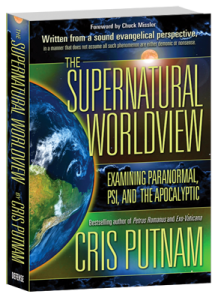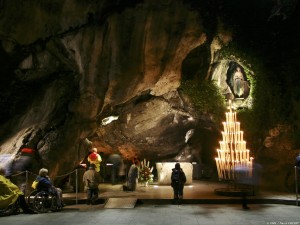 My new book The Supernatural Worldview to be released in May has a website http://www.supernaturalworldview.com/. I will be posting excerpts from the book as well as blogging on subjects and news articles relevant to the topics in the book. The book focuses on worldview apologetics for what I call the paranormal paradigm shift, an idea I explained here. Within you will find unconventional apologetics for the Christian faith by the way of defeaters for naturalism. These include: 1) the evidence for extrasensory perception, also called psi—a controversial area for Christian apologetics; 2) the near-death experience, which implies that consciousness survives bodily death; and 3) the evidence for spirits and apparitions, whether of human or nonhuman origin. While any one of these serves as a defeater for naturalism, the biblical worldview can account for all of the above.
My new book The Supernatural Worldview to be released in May has a website http://www.supernaturalworldview.com/. I will be posting excerpts from the book as well as blogging on subjects and news articles relevant to the topics in the book. The book focuses on worldview apologetics for what I call the paranormal paradigm shift, an idea I explained here. Within you will find unconventional apologetics for the Christian faith by the way of defeaters for naturalism. These include: 1) the evidence for extrasensory perception, also called psi—a controversial area for Christian apologetics; 2) the near-death experience, which implies that consciousness survives bodily death; and 3) the evidence for spirits and apparitions, whether of human or nonhuman origin. While any one of these serves as a defeater for naturalism, the biblical worldview can account for all of the above.
New Supernatural Worldview Website
Ground Zero with Clyde Lewis 1-31-2014
I talked to Clyde Friday night about the many astonishingly demonic stories appearing in the news lately.
Testing the Spirits (part 3) – Rome’s Marian Dogma
By Cris Putnam
 Finishing up the Testing the Spirits series (see part 1 and part 2) we now discuss the third test in 1 John 4: Does it conform to the apostolic teaching in the New Testament? “We are from God. Whoever knows God listens to us; whoever is not from God does not listen to us. By this we know the Spirit of truth and the spirit of error.” (1 Jn 4:6) Now I think it is fair to assume when John writes, “listens to us,” he means himself and his fellow apostles who knew Jesus during his three year earthy ministry. Thus, for this final test we ask, when you bring God’s word to bear upon the teaching and those teaching it, does it agree and do they respond to it?
Finishing up the Testing the Spirits series (see part 1 and part 2) we now discuss the third test in 1 John 4: Does it conform to the apostolic teaching in the New Testament? “We are from God. Whoever knows God listens to us; whoever is not from God does not listen to us. By this we know the Spirit of truth and the spirit of error.” (1 Jn 4:6) Now I think it is fair to assume when John writes, “listens to us,” he means himself and his fellow apostles who knew Jesus during his three year earthy ministry. Thus, for this final test we ask, when you bring God’s word to bear upon the teaching and those teaching it, does it agree and do they respond to it?
Jesus warned us “Beware of false prophets, who come to you in sheep’s clothing but inwardly are ravenous wolves.”(Mt 7:15) This applies even if they work miracles, so be cautious, “For false christs and false prophets will arise and perform great signs and wonders, so as to lead astray, if possible, even the elect.”(Mt 24:24) Jesus is telling us that miracles can be deceptive, this is hard because many people report things that seem beneficial like healings, but even so you must compare their ideas to biblical doctrine. This can be especially difficult when you see what appears to be good fruit.
Every year, nearly 6 million pilgrims visit Lourdes, France because “Mary” was said to appear there. People report being healed from diseases and see apparitions of Mary. However, few Catholics are aware of the dubious origin of “Our Lady of Lourdes.” The apparition first appeared to an impressionable teenager, Bernadette Soubirous under very questionable circumstances. But what is astounding is that Bernadette originally never believed it to be Mary until she was pressured by a local priest. I quote from Lynn Picknett’s excellent work on the paranormal, Flight’s of Fancy:
In February 1858, fourteen-year-old Bernadette Soubirous had discovered a strange creature, apparently suspended between the branches of a tree. It glowed, smiled and beckoned. The future Catholic Saint did not, as in the Hollywood version, fall enraptured to her knees, but ran home to grab a bottle of holy water to throw at ‘that thing’, as she called the vision. She believed it to be a demon, sent by the devil to lure her to doom, and perhaps she was right.
…She took her extraordinary secret to the parish priest, the only man of letters she knew. History might have taken a different turn, had he not been a fierce defender of Mariolatry at a time when the status of the Virgin was being challenged within the Catholic Church.[1]
The priest transformed this phantasm into evidence for the Marian phenomenon and the rest is history. Astonishingly, Bernadette was heralded as a mystic, canonized as a saint in 1933, and even given her own feast day on the sixteenth of April. But how does Marian theology match up with the apostolic teaching?
Perhaps the clearest evidence that the Catholic view of Mary is legendary rather than historical is how the Marian mythology has evolved over time. Whereas the doctrine of Christ has remained stable since the early creeds, Marian dogma continues to evolve: 1) in 431, she was called the “Mother of God”; 2) by 600, prayers were officially offered to Mary; 3) in 649, Pope Martin I stressed the perpetual nature of Mary’s virginity declaring her the “blessed ever-virginal and immaculate Mary”; 4) in 1854 came the dogmatic assertion of the Immaculate Conception (that she was born sinless); 5) in 1950, we have the Assumption of Mary (her body was taken to heaven); 6) as recently as 1965, she was proclaimed “Mother of the Church”; 7) currently there is an earnest campaign to proclaim Mary as “Co-Redemptrix Mediatrix of All Graces” and “Advocate for the People of God.” (The latter is widely accepted and taught but has not been dogmatized due to the potential negative repercussions for ecumenism.) While number one can be uncontroversial when interpreted within the constraints of biblical theology, the dogmas of perpetual virginity, sinlessness, Immaculate Conception, bodily assumption, and mediatorship, along with the veneration of Mary and her images, are wholly inconsistent with Scripture. In lieu of the more extended discussion in my book with Tom Horn Petrus Romanus we examine the latter “Co-Redemptrix Mediatrix of All Graces” in light of John’s admonition to test the spirits against the apostolic teaching.
Mary was given the title “Mediatrix” in the papal bull “Ineffabilis” of Pope Pius IX, the same document that proclaimed her immaculate conception. In 2012, Pope Benedict XVI affirmed this blasphemy when he referred to her as “the mediator of God’s blessing for the world.” Rome’s theologians argue it is an inference from her role in the incarnation of the God-man Christ Jesus. They further claim she had a role in His sacrifice on the cross to God the Father for the sake of the redemption of mankind. While there is nothing in the Bible to support it, they extend the role to the more demanding sense that, after her death, “Mary’s intercessory co-operation extends to all graces, which are conferred on mankind, so that no grace accrues to men, without the intercession of Mary.”[2] This is untenable and idolatrous. Let’s compare a few more Scriptures with Rome’s increasingly Marian mythology.
| Sacred Scripture (underline added) | Roman Dogma (underline added) |
| “Jesus saith unto him, I am the way, the truth, and the life: no man cometh unto the Father, but by me” (Jn 14:6).
“Come unto me, all ye that labour and are heavy laden, and I will give you rest” (Mt 11:28). |
“From that great treasure of all graces, which the Lord has brought, nothing, according to the will of God, comes to us except through Mary, so that, as nobody can approach the Supreme Father except through the Son, similarly nobody can approach Christ except through the Mother.” —Pope Leo 13th[3] |
| “And I will put enmity between thee and the woman, and between thy seed and her seed; it [He] shall bruise thy head, and thou shalt bruise his heel” (Ge 3:15).
“And the God of peace shall bruise Satan under your feet shortly. The grace of our Lord Jesus Christ be with you. Amen” (Ro 16:20).
|
“All our hope do we repose in the most Blessed Virgin—in the all fair and immaculate one who has crushed the poisonous head of the most cruel serpent and brought salvation to the world: in her who is the glory of the prophets and apostles, the honor of the martyrs, the crown and joy of all the saints.” —Pope Pius IX [4] |
| “For it pleased the Father that in him should all fulness dwell; And, having made peace through the blood of his cross, by him to reconcile all things unto himself; by him, I say, whether they be things in earth, or things in heaven” (Col 1:19–20).
|
“In the power of the grace of Redemption merited by Christ, Mary, by her spiritual entering into the sacrifice of her Divine Son for men, made atonement for the sins of men, and (de congruo) merited the application of the redemptive grace of Christ. In this manner she co-operates in the subjective redemption of mankind.”[5] |
| “For there is one God, and one mediator between God and men, the man Christ Jesus.” (1 Ti 2:5).
|
“Mary is the Mediatrix of all graces by her intercession in Heaven (Mediatio in speciali). Since her assumption into Heaven, Mary co-operates in the application of the grace of Redemption to man.”[6]
|
While the last example is particularly offensive, according to Walter Martin, official Catholic sources have formulated it in even more blasphemous language as, “There is one Mediator between Christ and men, the Holy Mother Mary. Mary is the way, the truth and the life. No man comes to Jesus but by Mary.”[7] This astonishing phrasing has the earmark of the demonic as it is deliberately designed to mock 1Timothy 2:5 and John 14:6 by usurping Christ’s unique role and authority. No matter what visions, emotional passions, and physical healings are associated with the Marian paranormal phenomenon, it is not from God.
As if this is not bad enough, the majority of Romanists now position the imposter as “Coredemptrix,” implying that she is involved in the task of saving sinners. While savvy Catholic theologians are hesitant to sign on, the title is tacitly approved by the Catholic Magisterium. In a 1918, Pope Benedict XV wrote:
As the blessed Virgin Mary does not seem to participate in the public life of Jesus Christ, and then, suddenly appears at the stations of his cross, she is not there without divine intention. She suffers with her suffering and dying son, almost as if she would have died herself. For the salvation of mankind, she gave up her rights as the mother of her son and sacrificed him for the reconciliation of divine justice, as far as she was permitted to do. Therefore, one can say, she redeemed with Christ the human race.[8]
It is because of arguments like this that the term non sequitur was invented. Mary did not allow Christ to die on the cross; she certainly would have prevented it if she could have. Did she suffer for our sins? In John 19, Jesus speaks to Mary Magdalene, Mary the mother of Cleophas, the Apostle John, and His mother Mary. I’m sure it was terrible for the others as well. Does it follow that they all suffered for our sins as well? She did not give up her rights as mother, the Roman authorities arrested Jesus, she had no choice in the matter and she certainly did not redeem anyone. Do Catholic leaders not see the fallacious special pleading in this sophomoric reasoning? It is hard to believe an alleged intellectual would publicly advance such poor argumentation. It seems, in the stupefying spirit of antichrist, the pope went to extravagantly inept lengths to diminish Christ’s redemptive work.
Unfortunately, it has only festered since. According to a 1997 Newsweek cover story, Pope John Paul II had “received 4,340,429 signatures from 157 countries—an average of 100,000 a month—supporting the proposed dogma. Among the notable supporters are Mother Teresa of Calcutta, nearly 500 bishops and 42 cardinals, including John O’Connor of New York, Joseph Glemp of Poland and half a dozen cardinals at the Vatican itself.”[9] The Marian phenomenon has increased significantly since then and it seems the only reason the title has not been officially dogmatized is in deference to ecumenism. The apparition that appears to thousands now calls itself the “Coredemptrix.”[10] Clearly, this phantom femme fatale is an ambitious usurper of Christ’s unique and incomparable role. This is unmistakably in the spirit of antichrist.
The latter half of this post is excerpted from the book I co-authored with Tom Horn, Petrus Romanus, which contains a more thorough examination of Marian dogmas as well as other Catholic teachings. If you would like a signed copy please order here.
[1] Lynn Picknett, Flights of Fancy (London: Ward Lock, 1987), 82-83.
[2] Ludwig Ott, Fundamentals of Catholic Dogma, 213.
[3] Pope Leo XIII, Rosary Encyclical, “Octobri mense” (1891) as quoted in Ludwig Ott, Fundamentals of Catholic Dogma, 213.
[4] Pope Pius IX, “Ineffabilis Deus,” Papal Encyclicals Online, December 8, 1854, viewable here: last accessed January 5, 2012, http://www.papalencyclicals.net/Pius09/p9ineff.htm.
[5] Ludwig Ott, Fundamentals of Catholic Dogma, 213.
[6] Ludwig Ott, Fundamentals of Catholic Dogma, 213.
[7] Walter Martin, The Roman Catholic Church in History (Livingston, NJ: Christian Research Institute, 1960), 49.
[8] Pope Benedict XV, Apostolic Letter Inter Soldalica, AAS 1918, 181.
[9] Kenneth L Woodward and Andrew Murr, “Hail Mary,” Newsweek, Vol. 130 Issue 8, (08/25/97), 48.
[10] Amsterdam, “Lady of All Nations,” channeled messages by Ida Peerdeman. For more information, see: last accessed, January 24, 2012, http://www.ladyofallnations.org/dogma.htm.




